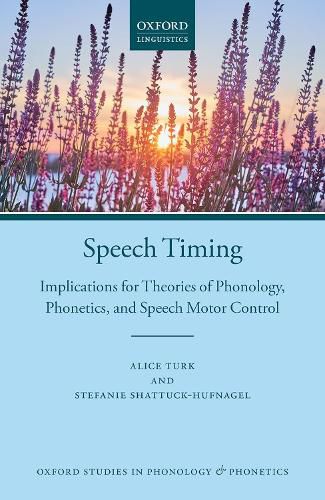Readings Newsletter
Become a Readings Member to make your shopping experience even easier.
Sign in or sign up for free!
You’re not far away from qualifying for FREE standard shipping within Australia
You’ve qualified for FREE standard shipping within Australia
The cart is loading…






This book explores the nature of cognitive representations and processes in speech motor control, based primarily on evidence from speech timing. It engages with the key question of whether phonological representations are spatio-temporal, as in the Articulatory Phonology approach, or symbolic (atemporal and non-quantitative); this issue has fundamental implications for the architecture of the speech production planning system, particularly with regard to the number of planning components and the type of timing mechanisms. Alice Turk and Stefanie Shattuck-Hufnagel outline a number of arguments in favour of an alternative to the Articulatory Phonology/Task Dynamics model. They demonstrate that a different framework is needed to account for evidence from speech and non-speech timing behaviour, and specifically that three separate planning components must be posited: Phonological Planning, Phonetic Planning, and Motor-Sensory Implementation. The approach proposed in the book provides a clearer and more comprehensive account of what is known about motor timing in general and speech timing in particular. It will be of interest to phoneticians and phonologists from all theoretical backgrounds as well as to speech clinicians and technologists.
$9.00 standard shipping within Australia
FREE standard shipping within Australia for orders over $100.00
Express & International shipping calculated at checkout
This book explores the nature of cognitive representations and processes in speech motor control, based primarily on evidence from speech timing. It engages with the key question of whether phonological representations are spatio-temporal, as in the Articulatory Phonology approach, or symbolic (atemporal and non-quantitative); this issue has fundamental implications for the architecture of the speech production planning system, particularly with regard to the number of planning components and the type of timing mechanisms. Alice Turk and Stefanie Shattuck-Hufnagel outline a number of arguments in favour of an alternative to the Articulatory Phonology/Task Dynamics model. They demonstrate that a different framework is needed to account for evidence from speech and non-speech timing behaviour, and specifically that three separate planning components must be posited: Phonological Planning, Phonetic Planning, and Motor-Sensory Implementation. The approach proposed in the book provides a clearer and more comprehensive account of what is known about motor timing in general and speech timing in particular. It will be of interest to phoneticians and phonologists from all theoretical backgrounds as well as to speech clinicians and technologists.